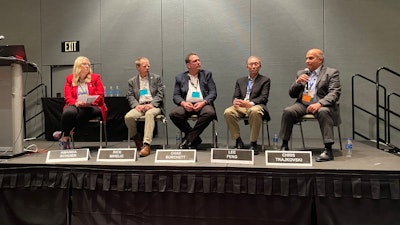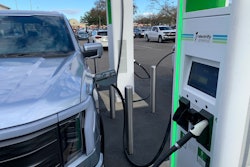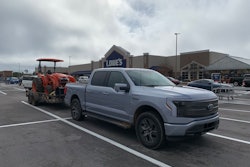
It might be time for ATA’s Technology & Maintenance Council (TMC) to amend its name.
The organization’s focus on technology and vehicle maintenance hasn’t changed, but the continuing complexity of medium- and heavy-duty trucks and trailers has forced it to expand its focus.
On Tuesday afternoon during its Annual Meeting in Orlando, TMC again turned its attention toward what could easily be the third pillar of its operation — safety.
Continuing a conversation that started Monday during a service provider study group task force meeting, Tuesday’s technical session on Electric Vehicle Battery Safety Guidelines was a lively, immensely informative panel discussion on just how fundamentally different battery electric vehicles (BEV) are from the diesel trucks North American transportation has relied upon for decades.
Panelists on stage during the discussion from Amazon, Trova, Nikola and the North American Council for Freight Efficiency (NACFE) admitted there aren’t a ton of BEVs moving loads on American highways yet but believe the increased proliferation of the technology in the Class 8 sector is only a matter of when, not if. Shippers, and by extension the general public, is demanding cleaner vehicles and decarbonization from the transportation industry.
As such, anyone in the business of maintaining or repairing commercial trucks that intends to remain in that business in the decades to come need to take time to understand the danger BEVs can pose.
[RELATED: TMC hitting the gas on EV safety recommended practice]
“These vehicles are here,” says NACFE’s Rick Mihelic, who kicked off Tuesday’s session with an overview of current BEV adoption rates and usage areas. Mihelic says NACFE research indicates commercial BEVs have been registered in all 50 states and production levels for the equipment continue to rise.
“We see new manufacturers entering the market almost every week,” he says. “We are at the very start of this. More [BEVs] are coming and adoption is going to advance rapidly.”
The panelists say that means fleets, dealers, service shops and their technicians need to advance their technical product education even faster.
How?
Trova’s Chad Burchett says it will be “critical that everyone follow OEM recommendations.”
These vehicles have a lot of amperage looking to get out through the path of least resistance, he says, and technicians who don’t understand that risk could put themselves and their colleagues in danger.
For their part, BEV manufacturers are diligently working to develop that guidance.
Chris Trajkovski says Nikola has gone to market with a service strategy most should recognize. The company is developing a nationwide dealer network and will also enable large fleet accounts to perform service on their equipment. Trajkovski says Nikola has constructed a two-step technical training program for technicians — that also requires a pre-requisite — that any technician must complete before being approved to service a Nikola vehicle.
The panelists also note the trucking industry will need clarifications on some myths and realities of battery-powered vehicles. Burchett mentions thermal events, “engineer speak for a fire.”
He says in a case where a battery may have been damaged while in use, it often takes a few minutes for a fire to begin. Burchett says anyone driving a BEV who believes a thermal event could be imminent will need to exit a roadway immediately, park the vehicle in a safe place, exit the cab, flip the safety disconnect and call emergency services from a safe distance.
[RELATED: TMC focuses on powertrains of the future]
Amazon’s Lee Feng agrees, adding OEMs need to be intentional about considering a customer’s point of view when writing safety practices. Because the technology is so new and dangerous, OEMs cannot assume their audience knows anything about BEV safety.
Burchett references an industry veteran who jumped into a BEV without any experience, turned on the key and assumed the battery was dead because it didn’t immediately turn on like an internal combustion engine would. Burchett says BEVs take a few seconds to power up once they’re turned on but says “if you’ve never been in one before, you’re going to make that mistake.”
Adds Mihelic, “A learn as you go approach is not really acceptable in a battery electric world.”
Similar guidance will be necessary for shop work. Burchett says BEV service bays should be roped off and isolated within shops and only approved technicians should be allowed into the area. Feng adds damaged BEVs should never be parked indoors until they have been properly de-energized and not at risk of a fire. And once any service event begins, technicians will need to follow all OEM guidance to the letter to ensure safety throughout the work. Mihelic likens the high level of caution to aircraft mechanics; there are no corners — or orange cables — that can be cut around a BEV.









